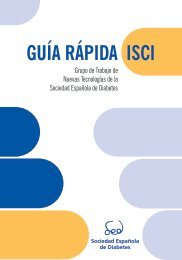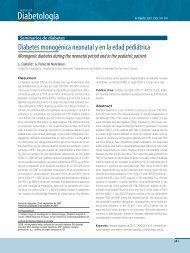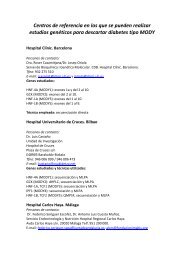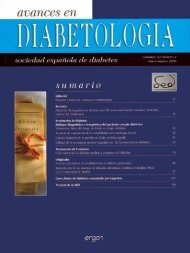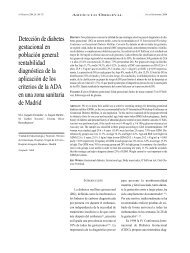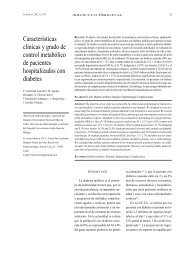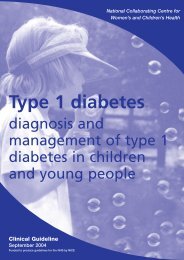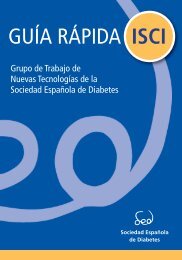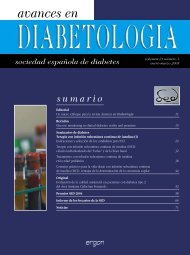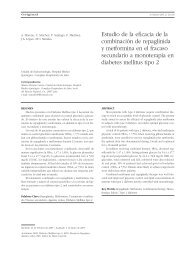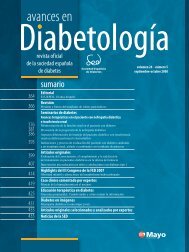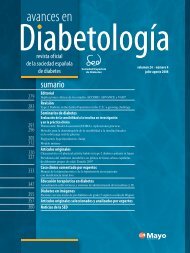00A PORT Y LOMO AVA.indd - Sociedad Española de Diabetes
00A PORT Y LOMO AVA.indd - Sociedad Española de Diabetes
00A PORT Y LOMO AVA.indd - Sociedad Española de Diabetes
You also want an ePaper? Increase the reach of your titles
YUMPU automatically turns print PDFs into web optimized ePapers that Google loves.
avances en<br />
Diabetología<br />
Av Diabetol. 2007; 23(1): 40-46<br />
Seminarios <strong>de</strong> diabetes<br />
Consejos prácticos para el ajuste <strong>de</strong>l tratamiento<br />
insulínico en el ejercicio físico<br />
Practical recommendations for adjustments in insulin therapy in relation to physical exercise<br />
G. Carreras, A. Pérez a<br />
Servicio <strong>de</strong> Pediatría. a Servicio <strong>de</strong> Endocrinología y Nutrición. Hospital <strong>de</strong> la Santa Creu i Sant Pau. Barcelona<br />
Resumen<br />
La práctica <strong>de</strong> ejercicio físico ofrece al paciente con diabetes los<br />
mismos beneficios que a la población no diabética. A<strong>de</strong>más, el ejercicio<br />
pue<strong>de</strong> contribuir a mejorar diversos aspectos <strong>de</strong> la diabetes.<br />
Sin embargo, en los pacientes con diabetes tipo 1 o tipo 2 insulinopénicos,<br />
no sólo no mejora el control glucémico, sino que, frecuentemente,<br />
comporta oscilaciones <strong>de</strong> los niveles <strong>de</strong> glucemia, sobre<br />
todo un aumento significativo <strong>de</strong>l riesgo <strong>de</strong> hipoglucemia, tanto durante<br />
el ejercicio como <strong>de</strong>spués <strong>de</strong> éste. Ello provoca, en no pocas<br />
ocasiones, un bajo cumplimiento <strong>de</strong> los programas <strong>de</strong> ejercicio físico,<br />
e incluso que algunos profesionales sanitarios <strong>de</strong>saconsejen su<br />
realización. Aunque la información disponible no admita establecer<br />
unas directrices fijas, sí permite elaborar unas recomendaciones que,<br />
utilizadas <strong>de</strong> forma flexible, pue<strong>de</strong>n aplicarse a la mayor parte <strong>de</strong> los<br />
pacientes y situaciones, así como que éstos disfruten <strong>de</strong> la práctica<br />
<strong>de</strong> ejercicio sin provocar un <strong>de</strong>terioro <strong>de</strong>l control metabólico. En este<br />
artículo se proponen unas recomendaciones para el ajuste <strong>de</strong>l<br />
tratamiento <strong>de</strong> la diabetes durante y <strong>de</strong>spués <strong>de</strong>l ejercicio físico basadas<br />
en la fisiología <strong>de</strong> la respuesta metabólica al ejercicio, los escasos<br />
estudios disponibles que evalúan diferentes estrategias y la<br />
propia experiencia <strong>de</strong> los autores.<br />
Palabras clave: diabetes, ejercicio físico, hipoglucemia, hiperglucemia,<br />
insulinoterapia.<br />
Abstract<br />
The same beneficial effects of physical activity reported for the general<br />
population can be exten<strong>de</strong>d to diabetic subjects. In addition, it<br />
can improve many other factors related to diabetes. Nevertheless, in<br />
type 1 and in insulinopenic type 2 diabetic patients, exercise does<br />
not improve glycemic control because it is usually associated with<br />
large excursions in blood glucose levels and, especially, with an increased<br />
risk of hypoglycemic events during and after the activity. In<br />
consequence, patient adherence to physical activity programs is frequently<br />
low, and many health care provi<strong>de</strong>rs do not even recommend<br />
it. Although the available information is insufficient to <strong>de</strong>fine<br />
strict gui<strong>de</strong>lines, it is possible to establish a number of recommendations<br />
that can be used, with flexibility, by most patients and in the<br />
majority of the situations, allowing them to enjoy exercise without a<br />
significant <strong>de</strong>terioration of their metabolic control. In this paper, the<br />
authors propose some practical recommendations for the adjustment<br />
of insulin therapy during and after physical exercise, based on<br />
the physiology of the metabolic response to exercise, on the limited<br />
available studies that evaluate different strategies, and on the experience<br />
of the authors themselves.<br />
Key words: diabetes mellitus, physical exercise, hypoglycemia, hyperglycemia,<br />
insulin therapy.<br />
Introducción<br />
Durante el ejercicio aumentan las necesida<strong>de</strong>s energéticas<br />
<strong>de</strong>l músculo. Para satisfacer estas necesida<strong>de</strong>s, en<br />
la persona no diabética se producen fisiológicamente<br />
una disminución <strong>de</strong> los niveles <strong>de</strong> insulinemia y un aumento<br />
<strong>de</strong> los niveles plasmáticos <strong>de</strong> hormonas contrarreguladoras<br />
o hiperglucemiantes: glucagón, catecolaminas,<br />
cortisol y hormona <strong>de</strong>l crecimiento (figuras 1 y<br />
Fecha <strong>de</strong> recepción: 12 <strong>de</strong> enero <strong>de</strong> 2007<br />
Fecha <strong>de</strong> aceptación: 15 <strong>de</strong> enero <strong>de</strong> 2007<br />
Correspon<strong>de</strong>ncia:<br />
G. Carreras González. Servicio <strong>de</strong> Pediatría. Hospital <strong>de</strong> la Santa Creu<br />
i Sant Pau. Sant Antoni M.ª Claret, 167. 08025 Barcelona.<br />
Correo electrónico: gcarreras@santpau.es<br />
Lista <strong>de</strong> acrónimos citados en el texto:<br />
HC: hidratos <strong>de</strong> carbono; ISCI: infusión subcutánea continua <strong>de</strong> insulina.<br />
40



